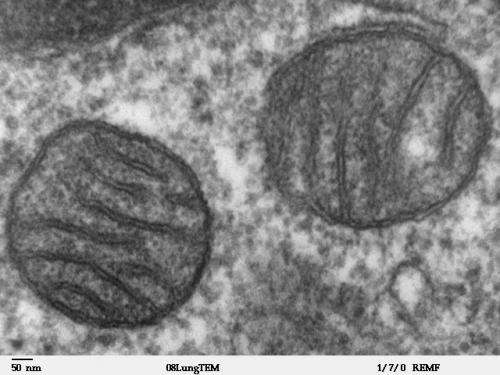February 3, 2021 feature
Neural activity controls mitochondrial transfer of RNA modifiers to the nucleus

In a recent paper in RNA Biology, researchers show that mitochondria translocate their key RNA methyltransferase enzyme, TRMT1, into host cell nuclei in response to neural activity. This subcellular relocalization of key RNA modifiers suggests a new understanding of how neurons plastically reconfigure their nuclei as network dynamics change.
While epigenetic processes involving DNA methylation and histone modifications are known to be critical in learning and memory, the role of RNA modifications in cognitive function has been less well characterized. Mutations in three RNA methyltransferase genes have recently been linked to intellectual disability: an 2'-O-methyltransferase FTSJ1, the m5C methyltransferase NSUN2, and the m2,2G tRNA methyltransferase TRMT1. The latter is responsible for generating an N2,N2-dimethylguanosine at position 26 in most cytosolic and mitochondrial tRNAs using S-adenosyl-L-methionine as the methyl donor. It may also act on various rRNA and mRMAs.
Presently, there are over 100 known types of tRNA modifications ranging from simple methylation to complex modifications involving multiple chemical groups. An example of a common mRNA modification would be pseudouridylation, which converts a uridine (U) to a pseudouridine (Ψ). The new mRNA vaccines against SARS-CoV-2, for example, incorporate pseudouridine to create a less immunogenic vector with increased translational capacity and biological stability. Mitochondrial tRNAs, tRNA synthetases, and ribosomes are completely distinct from their counterparts deployed in the cytosol. To get into the mitochondria, TRMT1 uses a presumptive N' terminal mitochondrial localization sequence (MLS), which can access specific transporters on the inner and outer mitochondrial membranes. Alternative splicing removes the MLS to create a second isoform of TRMT1 that remains in the cytoplasm. Both forms also contain a weak C' terminal nuclear localization sequence (NLS).
Additionally, there is another homologous TRMT1-like gene (TRMT1L), which has a stronger NLS, and is found in the nucleus in close association with the nucleolus. TRMT1L has a more specific activity in that it methylates a subset of the cytosolic tRNAs, primarily the (tRNA-Ala(AGC) isocoders. These isocoders are tRNAs that share the same anticodon but diverge elsewhere in their sequence. It is believed that TRMT1L originated at the base of vertebrate evolution through a duplication of the TRMT1 gene. However, in humans today, there is only around 20% sequence homology, although the domain structure of the two proteins remains relatively similar.
The researchers found that depolarization of neurons using KCL caused the relocation of TRMT1 from mitochondria and cytosol, as well as the relocation of TRMT1L from the nucleolus, into small punctate compartments of the nucleus. Although short depolarization bursts with KCL has been used to mimic long-term potentiation (LTP) via induction of immediate early genes, it is not a perfect simulator of real neural activity. In order to do that, fast electrical stimulation should be used to generate individual spike trains from individual neurons.
An important question in all this is how mitochondria know that the neuron is firing, and furthermore, how they send TRMT1 to the nucleus. While it is known that mitochondria can rapidly respond to the influx of calcium that occurs during depolarization of tiny pre- or postsynaptic structures, these signals would likely wash out, temporally, near the nucleus inside of a large neuron.
One idea put forward some time ago is that mitochondria should be able to directly sense changes in electrical potential, and respond in kind with changes in their own membrane potential. So-called "mitoflashes" appear to involve rapid generation of superoxide or other radicals, along with significant changes in temperature, and even small contractions and twitches. In this view, excitable mitochondria may not only be able to feel spikes or mini synaptic potentials, but they may actually be able to incite them locally with the small confines of dendrites. Since that publication, some evidence for dendritic mitoflashes as a putative signal for stabilizing long-term synaptic plasticity has been found.
As far as the second question, the transfer of molecules from mitochondria to nucleus is a nice trick that cells regularly employ to control genes and epigenetic structure. For example, ATFS-1 (activating transcription factor associated with stress), which mediates the mitochondrial uncoupling response, is often translocated into the nucleus to modify gene expression. Similarly, PDC (pyruvate decarboxylase) can enter the nucleus under certain conditions to generate acetyl-CoA for histone acetylation.
For the case of TRMT1, the presence of a strong MLS peptide overrides the weak NLS and the protein is initially targeted to mitochondrial transporters upon being synthesized. After entry, various proteases immediately cleave the signal sequence and activate the protein. Later on, contingent upon sufficient depolarization or other presumptive mitoflash events, the protein can exit the mitochondria. This time, lacking the MLS, the weak NLS eventually brings the protein back home to the nucleus.
More information: Nicky Jonkhout et al. Subcellular relocalization and nuclear redistribution of the RNA methyltransferases TRMT1 and TRMT1L upon neuronal activation, RNA Biology (2021). DOI: 10.1080/15476286.2021.1881291
© 2021 Science X Network




















